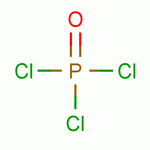|
Physicochemical properties
|
Color and smell status: colorless smoky liquid with pungent odor
|
|
Toxicity: Poisoning
|
Flammability: non-flammable
|
|
Density: 1.675
|
Volatility: Volatile
|
|
Corrosion: strong corrosion
|
Boiling point: 105.8℃ |
|
Stability: unstable
|
Melting point: 1.25℃
|
|
Alkalinity or acidity:acidity
|
Deliquescence: easy to decompose
|
|
Flash point: 105.8 ℃
|
Solubility: soluble in alcohol, soluble in water
|
|
Moisture absorption: exposed to moist air, hydrolyzed to phosphoric acid and hydrogen chloride
|
|
Uses
|
Used in plasticizers, pesticides, dye intermediates, chlorinating agents, catalysts, and flame retardants. Uses of electronic grade phosphorus oxychloride are mainly used for N-type dopant sources in the solar energy industry, integrated circuits, separation devices, and the semiconductor industry. The reaction effect is best at 0°C.
|
|
Hazard category
|
Class 6.1 Toxic and Class 8 Dangerous Goods
|
|
Fire-fighting measures
|
Fire extinguishing method: fire extinguishing agent: dry powder, dry sand. Prohibition of water
|
|
Emergency treatment
|
Skin contact: Take off contaminated clothing immediately and rinse with plenty of running water for at least 15 minutes. Seek medical attention
Eye contact: Lift the eyelid immediately, and rinse thoroughly with plenty of running water or normal saline for at least 15 minutes. Seek medical attention
Inhalation: quickly leave the scene to a place with fresh air. Keep the airway unobstructed. If breathing is difficult, give oxygen. If breathing stops, give artificial respiration immediately. Seek medical attention
Ingestion: Rinse mouth with water, gastric lavage for those with no symptoms of corrosion. Avoid taking oils. Seek medical attention
|
|
Packaging, storage, transportation
|
Plastic drums of 300 kg/drum, stored in a cool, dry and well-ventilated warehouse. Keep away from fire and heat sources. The storage temperature does not exceed 25℃, and the relative humidity does not exceed 75%. The packaging must be sealed and protected from moisture. Mixed shipment and transportation with reducing agents, active metal powders, alcohols, edible chemicals, etc. are strictly prohibited. Transport as required by dangerous goods
|
 CN
China Suppliers > LongxingChem >
CN
China Suppliers > LongxingChem > 